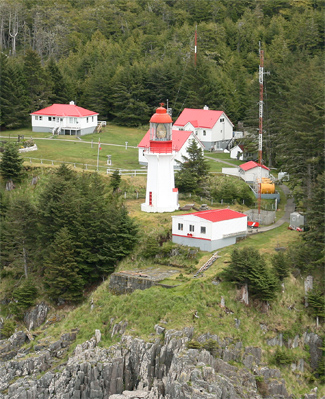Langara Point Lighthouse
Heritage Lighthouse
Village of Masset, British Columbia

General view
(© Kraig Anderson - lighthousefriends.com)
Address :
Langara Island, Village of Masset, British Columbia
Recognition Statute:
Heritage Lighthouse Protection Act (S.C. 2008, c 16)
Designation Date:
2015-02-12
Dates:
-
1913 to 1913
(Construction)
-
1913 to 1913
(Established)
Event, Person, Organization:
-
Colonel William Anderson (in collaboration with the Department of Marine and Fisheries)
(Architect)
Description of Historic Place
The Langara Point Lighthouse is a tapered, hexagonal, ribbed, reinforced-concrete lighthouse, measuring 7.6 metres (25 feet) tall. It is located on the north-west tip of Langara Island, which is part of the Haida Gwaii Islands adjacent to the Canada-United States border. The nearest community is the Village of Masset, located roughly 40 kilometres (25 miles) to the southeast. It is the first lighthouse on site, its construction dating to 1913.
There are seven related buildings on the site that contribute to the heritage character of the lighthouse:(1) the 1965 single 3-bedroom dwelling (junior); (2) the 1965 double 4-bedroom dwelling; (3) the 1962 single 4-bedroom dwelling (spare); (4) the 1938 Boathouse; (5) the 1975 Engine/Radio Beacon room; (6) the 1965 Workshop; and, (7) the 2000 Flammables building.
Heritage Value
The Langara Point Lighthouse is a heritage lighthouse because of its historical, architectural, and community values.
Historical values
The Langara Point Lighthouse is an excellent illustration of the campaign to provide aids to navigation on the West Coast of Canada. The tower is associated with the growth of trans-oceanic traffic to Prince Rupert. During the Second World War, the lighthouse was painted camouflage green and a radar station was built to monitor action in the North Pacific. The lighthouse at Langara Point is also representative of Canadian efforts to establish a network of recorders to give advance warnings for earthquakes and tsunamis along the Pacific Coast after two devastating tsunamis in 1946 and 1964.
The Langara Point Lighthouse is an excellent example of the socio-economic development of the Dixon Entrance and the Haida Gwaii village of Masset, as well as a larger international community of fishermen, tourists, and shipping vessels who have used the lighthouse for guidance since 1913. In recent years, the island, with its iconic lighthouse, has been a popular destination for sport fishers and tourists.
Architectural values
The Langara Point Lighthouse is an excellent example of a tapered hexagonal ribbed reinforced-concrete tower, a variant of the flying buttress design that was developed in the early 20th century. The proportions of the structure contribute to its modern silhouette. The simple form of the light tower is enhanced by the monolithic, smooth-surfaced concrete construction.
Constructed with excellent craftsmanship and materials, the Langara Point Lighthouse has an elegant design that has weathered its climatic conditions well. It is also an excellent example of a lighthouse that functions within the larger context of a fully-equipped lightstation. The lightstation includes three lightkeepers’ dwellings, an engine/radio beacon room, a boathouse, a flammables room, and a workshop. The group of buildings is highly evocative of the lightkeeping tradition.
Community values
The Langara Point Lighthouse establishes its local maritime character as it stands in a small grassy clearing, at the edge of a substantial cliff on the north end of a small, rugged, heavily wooded island. The lighthouse and its ancillary buildings dominate the small, manicured site. The lighthouse is clearly visible from the water, while the related buildings are obscured from the water by heavy woods and are best viewed from the lightstation.
The Langara Point Lighthouse also functions as a weather reporting station and contributes to search and rescue efforts in the area. Easily accessible by boat, it is a prominent tourist destination, a familiar landmark for commercial marine traffic of the area, and a symbol of the local marine community.
Related buildings
Seven related buildings, as listed in section 1, contribute to the heritage character of the lighthouse.
Character-Defining Elements
The following character-defining elements of the Langara Point Lighthouse should be respected:
— its location on the edge of a cliff on the north-west tip of Langara Island;
— its intact, as-built structural form, height, profile, and balanced proportions;
— its hexagonal, tapered, ribbed tower of smooth reinforced concrete;
— its cylindrical metal lantern with its domed ventilator and weathervane;
— its original First Order Fresnel lens;
— its concrete gallery with a circular metal railing surrounding the lantern;
— the simplicity of the scale and proportions of its brackets and edge profile of its lantern deck;
— the simple formed openings for its windows and pedimented door;
— its traditional red and white exterior colour scheme, consisting of white for the tower and red for the door, roof, gallery railing, and lantern; and,
— its visual prominence in relation to the water and landscape.
The following character-defining elements of the related buildings should be respected:
— their respective built forms and proportions;
— their traditional colour scheme consisting of white for the walls and red for the trim and roof; and,
— their contextual relationship to the lighthouse within a lightstation setting.